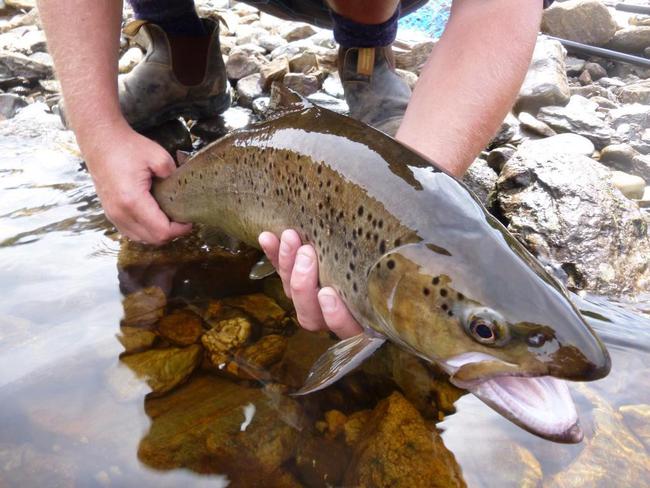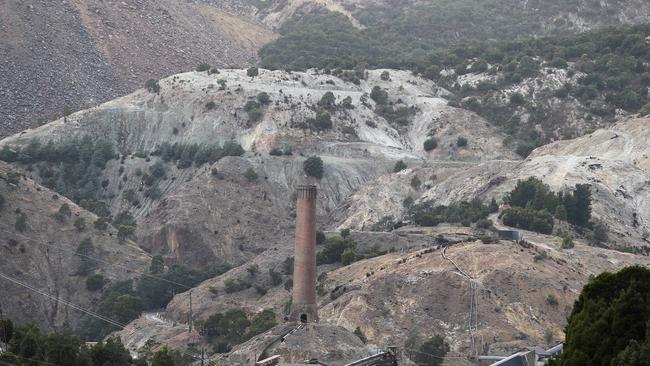Australian National University research finds Tasmanian lakes among the world’s worst for metal contamination
UPDATED: Taswater says it will review its records and examine whether water from contaminated lakes has transferred into Tasmanian water sources.

Politics
Don't miss out on the headlines from Politics. Followed categories will be added to My News.
UPDATED: TASWATER says it will review its records and examine whether water from contaminated lakes has transferred into Tasmanian water sources following the release of ANU research on metal concentrations in some wilderness lakes.
The authority said the health of the public was its “highest priority” and has assured Tasmanians the state’s drinking water meets Australian Drinking Water Guidelines and is safe.
It said: “We have reviewed our data sets for the systems and catchments that include these lakes and we do not have concerns for drinking water quality as a result of the claimed contamination.
“TasWater takes the quality of our water very seriously and is committed to protecting the
community so as an added precaution we will carry out a full review of all our records as well as assess any possible transfer of water from the identified lakes into water sources which supply ourtreatment facilities.”
EARLIER: Researchers have warned that high levels of heavy metal contamination found in some of Tasmania’s most iconic wild lakes poses a risk to anglers who eat fish caught from them.
Australian National University researchers have studied airborne contamination for the first time in Tasmania and found metal contaminants had travelled up to 130km from historical mining sites in Queenstown and Rosebery.
The study found six lakes, including Dove Lake at Cradle Mountain, had dangerous levels of metals, including lead, copper, arsenic and cadmium, with some readings exceeding the highest allowable levels in Australian and New Zealand sediment guidelines.

Academics urged more research into the effect on fish, algae and bacteria in those areas, with lead researcher Larissa Schneider saying there could be cause for health concerns.
“As we know, concentrations of contaminants increase as they travel up the food chain so this has implications for anyone who consumes fish from these areas,” the ANU academic said.
he worst affected lakes were, in order, Owen Tarn, Basin Lake, Perched Lake, Dove Lake, Lake Dobson and Lake Cygnus, with four of those within the Tasmanian Wilderness World Heritage Area. Lakes closer to mine sites had the highest levels of contamination. It was comparable to highly polluted rivers in Pakistan, Iran and China, Dr Schneider said.
EARLIER: THE state’s environment department says it is “aware” of research showing some iconic Tasmanian lakes are among the world’s most contaminated but says remediation is “not feasible”.
The Department of Primary Industries, Parks, Water and Environment has this morning responded to Australian National University research on metal contamination of South-West lakes, including Dove Lake at Cradle Mountain, that revealed dangerous levels of metal concentrations.

A spokeswoman said remediation was “not feasible” for the six affected lakes.
“The state government is aware of the research,” the DPIPWE spokeswoman said.
“It relates to airborne pollution as a result of metalliferous dust from historic mining activities dating back up to 150 years.
“It is important to know this information and equally important to understand that current environmental practices over the past two decades have ensured that this sort of contamination levels are no longer being created.”
EARLIER: ICONIC lakes within the Wilderness World Heritage Area have been so badly affected by West Coast mining that their metal contamination readings are among the worst in the world.
Australian National University researchers have studied airborne contamination for the first time in Tasmania and found metal contaminants had travelled up to 130km from historical mining sites in Queenstown and Rosebery.

The study found six lakes, including Dove Lake at Cradle Mountain, had dangerous levels of metals, including lead, copper, arsenic and cadmium, with some readings exceeding the highest allowable levels in Australian and New Zealand sediment guidelines.
Academics urged more research into the effect on fish, algae and bacteria in those areas, with lead researcher Larissa Schneider saying there could be cause for health concerns.
“As we know, concentrations of contaminants increase as they travel up the food chain so this has implications for anyone who consumes fish from these areas,” the ANU academic said. “We tested a number of metals and metalloids including selenium, where a study in the US proved that lower concentrations than the ones found in Tasmania had affected the ability of fish to reproduce.”
The worst affected lakes were, in order, Owen Tarn, Basin Lake, Perched Lake, Dove Lake, Lake Dobson and Lake Cygnus, with four of those within the Tasmanian Wilderness World Heritage Area. Lakes closer to mine sites had the highest levels of contamination. It was comparable to highly polluted rivers in Pakistan, Iran and China, Dr Schneider said.
MORE TASSIE NEWS:
‘WE’RE NOT OUT OF THE WOODS YET’
CANBERRA CALLED ON TO PROTECT RARE HANDFISH
NEW THEATRE FESTIVAL ATTRACTS BIG NAMES TO TASSIE
RAIN BRINGS MASSIVE RELEASE OF TENSION
JUNGLE JACQUI’S BACK AND READY TO RUMBLE
IT”S TIME TO RETIRE, SAYS MYER FIRE SURVIVOR
Wilderness Society state campaign manager Vica Bayley labelled the study, published in science of the Total Environment, a “devastating scientific revelation”.
“That Tasmanian icons like Dove Lake and Lake Dobson are global record holders in mining-related toxicity is an indictment on our laws and highlights the challenge of truly protecting conservation reserves from external factors like pollution,” Mr Bayley said.
“If World Heritage-listed lakes are polluted at alarming levels, what’s the impact on farmland, drinking water catchments and human health?”


Dr Schneider said the study raised serious questions about who was responsible for the environmental impacts. Testing found the largest contamination occurred when open-cut mining kicked off in 1930.
Tasmania was among the first to legislate an Environmental Protection Act in 1973 but the Labor government, led by Eric Reece, then exempted mining companies from those rules. But the sites were likely able to be remediated, Dr Schneider said.
“If [the Federal Government were to] develop a program that current industry should fund studies to assess what happened in former mines … I think that would be very, very important,” she said.
Tasmanian Minerals and Energy Council chief executive Wayne Bould said his body would look closely at the new research.
“We have a keen interest in remediating any problems that may be the result of any legacy issues over time,” he said.
The State Government and Environment Protection Authority were asked for comment.


